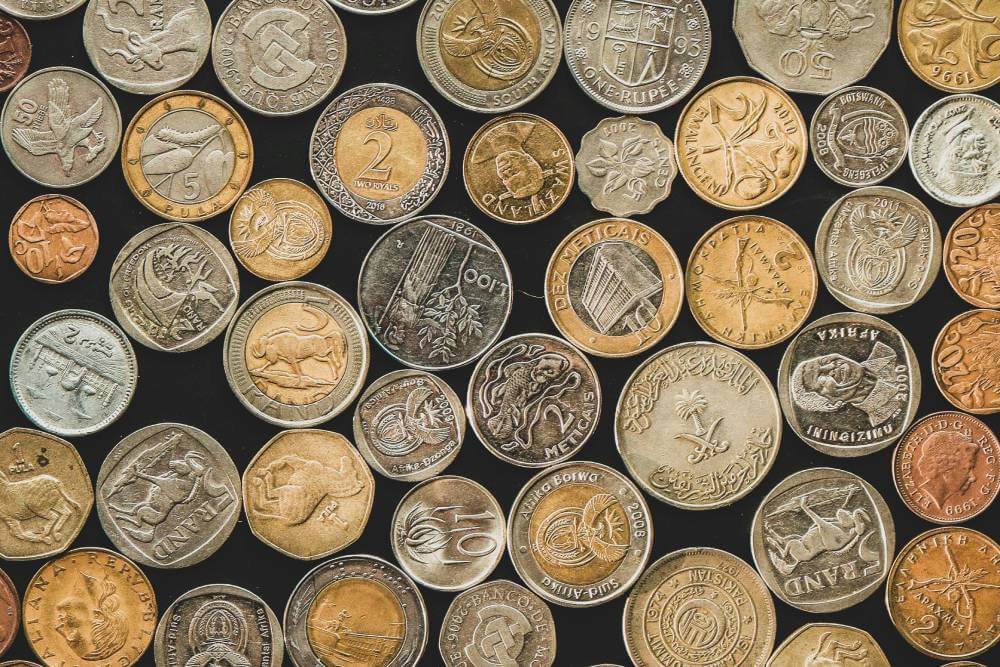If you’re a coin collector or love hunting for old coins, you’ve probably found some that are tarnished or worn. Coin collecting is a nostalgic hobby, but often, we get distracted, and the costs get in the way. You may want to clean them up but also worry about damaging them.
Well, we’re here to help! We’ve put together a list of safety tips for cleaning your valuable metal finds.
To Clean or Not to Clean?

Before you rush to clean an old coin, you need to determine if the coin is a collectible. High-value or historically significant coins like the Monroe Half Dollar or a rare vintage penny gain more value with their patina or aging marks. The wear, tone, and minor imperfections on these coins tell a story and are part of their charm, adding to their value. Cleaning these coins could unintentionally strip away that history, damage the original surface, and cause discoloration or abrasions that make them less appealing to collectors. In many cases, a cleaned coin could be worth significantly less than one left in its natural state. Especially for valuable coins.
That being said if the coin you’re dealing with is a sentimental find or something you’re not going to sell for profit, a gentle cleaning might be just what it needs to shine again. However, even in this case, the approach you take is crucial. Harsh chemicals, aggressive scrubbing, or improper handling can cause irreparable damage. Consulting a coin dealer for a professional evaluation before cleaning potentially valuable coins is highly recommended.
The tips below will show you how to clean old coins without damaging them. However, keep in mind that these methods are best for coins that don’t have much historical or monetary value. For valuable collectibles, professional evaluation and conservation are usually the best way to preserve their value.
How to Clean Old Rare Coins Without Messing Up Their Value?
When it comes to rare coins, less is more! Ancient coins especially require careful handling to preserve their authenticity and value. For valuable collectible coins, the safest way to clean them is to gently rinse them under running water—and that’s it. This simple method removes loose dirt without damaging the surface. If your coin has historical or monetary value, it’s best to leave the deep cleaning to a professional who can properly evaluate and clean it with specialized techniques.
But if you’re dealing with older coins that aren’t worth much or you’re not sure of their value, you can try light coin cleaning at home. These common household items like vinegar, baking soda, or just plain water can work depending on the metal. Here are a few tips to keep in mind:
Water Rinse: Always start with water. Gently rinse the coin under warm water to remove surface dirt.
Vinegar Soak: For tougher grime, soak the coin in white vinegar for a few minutes, then gently scrub with a soft toothbrush.
Baking Soda Paste: Baking soda paste can be used to remove tarnish from copper or silver coins, but be very careful not to scratch the surface.
Remember, always handle your coins gently, and don’t use abrasive materials that can cause permanent damage!
How to Clean Coins With Vinegar, Lemon Juice, Baking Soda and Soap?
Do you have some non-collectible or low-value dirty coins that need a little cleaning? Here’s a simple DIY method to bring back their shine. Using household items like vinegar, lemon juice, baking soda, and soap, you can remove dirt and oxidation without damaging the coins.
Another way is to soak the coins in Coca-Cola for a short time. The acidity of the soda removes corrosion, but be careful not to soak them for too long to damage the metal.
Materials
Distilled white vinegar (or fresh lemon juice)
Salt
Shallow plastic container
Cloth or paper towel
Baking soda
Dishwashing soap
Old toothbrush
Step 1: Mix It Up
1 cup white vinegar (or lemon juice) 1 tablespoon salt Stir until salt is dissolved.
Step 2: Fill a Container
Pour the vinegar-salt mixture into a shallow plastic container. Make sure it covers the coins. Add more of the mix if needed to cover the coins.
Step 3: Soak the Coins
Place the coins at the bottom of the container, and don’t let them touch each other or scratch. Soak for 15 minutes to allow the solution to dissolve the dirt and oxidation.
Step 4: Wipe
After soaking, remove the coins and wipe them with a cloth or paper towel. They should be shiny. If there’s still oxidation or stubborn dirt, return the coins to the solution and soak for 5-10 minutes.
Step 5: Scrub with Baking Soda
For a deeper clean, try scrubbing with baking soda:
Mix 1 tablespoon of baking soda with water to make a paste.
Use a soft toothbrush to scrub the surface of each coin.
After that, rinse the coins under water to remove the paste, and you’ll see a cleaner, shinier surface.
Step 6: Clean with Dish Soap
For coins that are still dirty or have built up grime, try a final clean with dish soap:
Fill a plastic container with about an inch of warm water.
Add a squirt of dishwashing soap and stir until bubbles form.
Put the coins in the soapy water and rub each one gently to remove any remaining dirt.
Rinse with warm water and let the coins air dry, or pat them dry with a soft cloth.
Now your old coins look new! Just be careful with valuable or collectible coins, as improper cleaning can devalue them.
How to Clean Old Silver Coins Safely?
To clean an old silver coin safely, you can use a simple method with aluminum foil and an electrolyte solution that works like magic without damaging the coin’s surface.
Here’s How to Do It
Get the Materials: Get a piece of aluminum foil. Then, fill a bowl with baking soda and water or salt and water. This will be the electrolyte solution that will clean the tarnish off your silver coin.
Wrap the Coin: Wrap your silver coin tightly in aluminum foil so the coin is fully covered.
Soak the Coin: Put the wrapped coin in the bowl with the electrolyte solution. Let it soak for a few minutes as the chemical reaction starts to work on the tarnish.
Unwrap and Rinse: After soaking, remove the aluminum foil and rinse the coin with water. The tarnish should lift, and the silver surface will be brighter and shinier.
Why This Works?
The aluminum foil and electrolyte solution combination creates a small electrochemical reaction that safely removes the tarnish from the silver without scratching or damaging the metal. It’s a quick and easy way to restore your silver coins.
Bonus Tip
Since silver tarnishes when exposed to air and moisture over time, it’s a good idea to store cleaned silver coins in a cool, dry place or protective holders so they don’t tarnish again.
How to Clean Old Copper Coins?

Cleaning old copper coins is easy but requires a gentle hand so as not to damage the surface of the coin. The safest and most effective way is with distilled water, and here’s why.
Steps to Clean Copper Coins
Use Distilled Water: Instead of tap water containing chemicals like chlorine and minerals that can corrode the coin, always use distilled water. This way, no harmful substances will touch copper.
Soak the Coins: Submerge the coins in a bowl of hot distilled water. Let it soak overnight or at least for several hours. This gentle soaking process will loosen the dirt and grime without damaging the surface of the metal.
Air-Dry: After soaking, remove the coins from the water and place them on a clean towel or cloth to air dry. Don’t wipe the coins, as this can scratch the surface.
The Science Behind It
Copper develops a beautiful patina over time due to oxidation. This bluish-green layer makes the coin look better and serves as a natural shield against further environmental damage. Stripping away this patina with harsh chemicals will expose copper to corrosion and irreversible damage.
Don’t use other cleaning agents, such as vinegar, salt, or abrasive tools, that can strip away the coin’s protective coating.
By following this method, you can preserve the beauty and value of your old copper coins without damaging the surface.
How to Clean Old Coins with Coke (If You’re Feeling Adventurous)
Cleaning old coins with Coca-Cola sounds crazy, but its phosphoric acid can be surprisingly effective in removing tarnish and grime from metal surfaces. However, since Coke is a strong cleaner, it should be used with caution so as not to damage your coins.
Steps to Clean Coins with Coke
Pour Coke into a Bowl: Fill a small plastic or glass bowl with Coca-Cola—just enough to cover your coins.
Soak the Coins: Drop the coins into the Coke and let it sit. The acidity of Coke will start to break down the dirt, and oxidation will form on the coins.
Check Every 15 Minutes: Don’t let the coins sit for too long! Check on them every 15 minutes to monitor the cleaning process and see if the acid is damaging the surface of the coin.
Rinse and Dry: Once you see that the corrosion has loosened or been removed, take the coins out and rinse them thoroughly with water (distilled water to avoid any further reaction). Then, air-dry them on a towel.
Tips
Don’t Soak Too Long: Coke is acidic enough to dissolve metal if left for too long, so keep your soak time under 30 minutes.
For Non-Collectible Coins: This method is best for non-collectible coins or coins with extreme dirt buildup that you don’t care about preserving in mint condition.
While Coke can produce shiny results, it’s always better to be cautious with rare or collectible coins. If in doubt, consult a professional before trying any DIY cleaning methods!
How to Clean Coins with Hydrogen Peroxide (Not for Old Coins)
Hydrogen peroxide is a strong cleaner that can remove dirt and sterilize coins. But while this method can make coins look clean and shiny, it’s not recommended for valuable or collectible coins. In the context of cleaning a coin, the powerful oxidation of hydrogen peroxide can damage the coin’s surface or reduce its value.
Steps to Clean Coins with Hydrogen Peroxide
Prepare a Bowl: Pour enough hydrogen peroxide into a small plastic or glass container to cover your coins.
Soak the Coins: Put your coins in the bowl, making sure they are fully submerged. Let them sit for 24 hours to loosen dirt, grime, and other buildup.
Rinse the Coins: After 24 hours, carefully remove the coins from the bowl and rinse with water to remove any remaining peroxide.
Dry the Coins: Pat the coins dry with a soft cloth or paper towel. Be gentle, as rough handling may scratch the coins.
Tips
Not for Collectibles: Hydrogen peroxide can damage the surface, so this method is unsuitable for rare or valuable coins.
Sterilization: Peroxide will also sterilize coins, which may be good if you handle them, especially if they’ve been stored in unsanitary conditions.
If you’re just cleaning modern or common coins that are not collectible, hydrogen peroxide can work wonders. But for older or rarer coins, you’re better off leaving the cleaning to the pros.
How to Clean Coins with Ketchup?
You’ve heard of all sorts of crazy ways to clean coins, but using ketchup might be the best way out. And for good reason — it’s not recommended. While ketchup has mild acids like vinegar and citric acid from tomatoes that can remove dirt and tarnish, it can also damage your coins.
Why not Use Ketchup?
Acid Risks: The acids in ketchup might remove tarnish, but they can also strip away surface details on collectible coins, reducing their value.
Messy Residue: Ketchup is thick and sticky, so it might be hard to rinse off completely, leaving behind residue that can cause further damage over time.
Uneven Cleaning: Ketchup may only clean in patches, leaving your coins looking spotty and uneven.
So when it comes to cleaning coins, skip the ketchup — it’s great for fries but not for your collectibles! Use distilled water, baking soda, or vinegar for better results.
How to Keep Your Coins Clean Longer?

To keep your coins shiny and intact for years to come:
Proper storage is key, especially for gold and silver coins, to preserve their value and prevent damage.
1. Handle with Care
Always hold coins between your thumb and index finger. This minimizes the chance of scratching or damaging the surface. Don’t touch the faces of the coins, as this can leave fingerprints and wear them.
2. Protect Your Hands
Wear gloves when handling collectible coins or after cleaning them. This simple step will prevent smudges and fingerprints from scratching the surface. The natural oils on your skin can corrode the coins over time, causing discoloration and loss of value.
3. Dryness
Moisture is the worst enemy of coins. It can cause discoloration and corrosion. Be extra careful with saliva; it can leave behind stubborn spots that are hard to remove. Always make sure your coins are dry before storing them.
4. Store
Invest in acid-free and PVC-free holders for your collectible coins. Acid and PVC can harm coins, PVC being the worst as it can leave a sticky, slimy green coating on the surface. Use coin flips, capsules, or specialized coin albums to protect and preserve your collection.
5. Keep Away from Direct Sunlight
Store coins in a cool, dark place. Direct sunlight can fade colors and cause temperature fluctuations, leading to moisture buildup. A climate-controlled environment is best for long-term storage.
6. No Household Cleaners
Never use household cleaners or abrasive materials on your coins; they can scratch and damage them. Use the gentle cleaning methods above if you need to clean them.
7. Inspect Regularly
Make it a habit to check your coins regularly for wear, tarnish, or discoloration. Catching issues early will help you take preventive measures before damage occurs.
By following these tips, you can keep your coins in mint condition and preserve their beauty and value for years to come.





